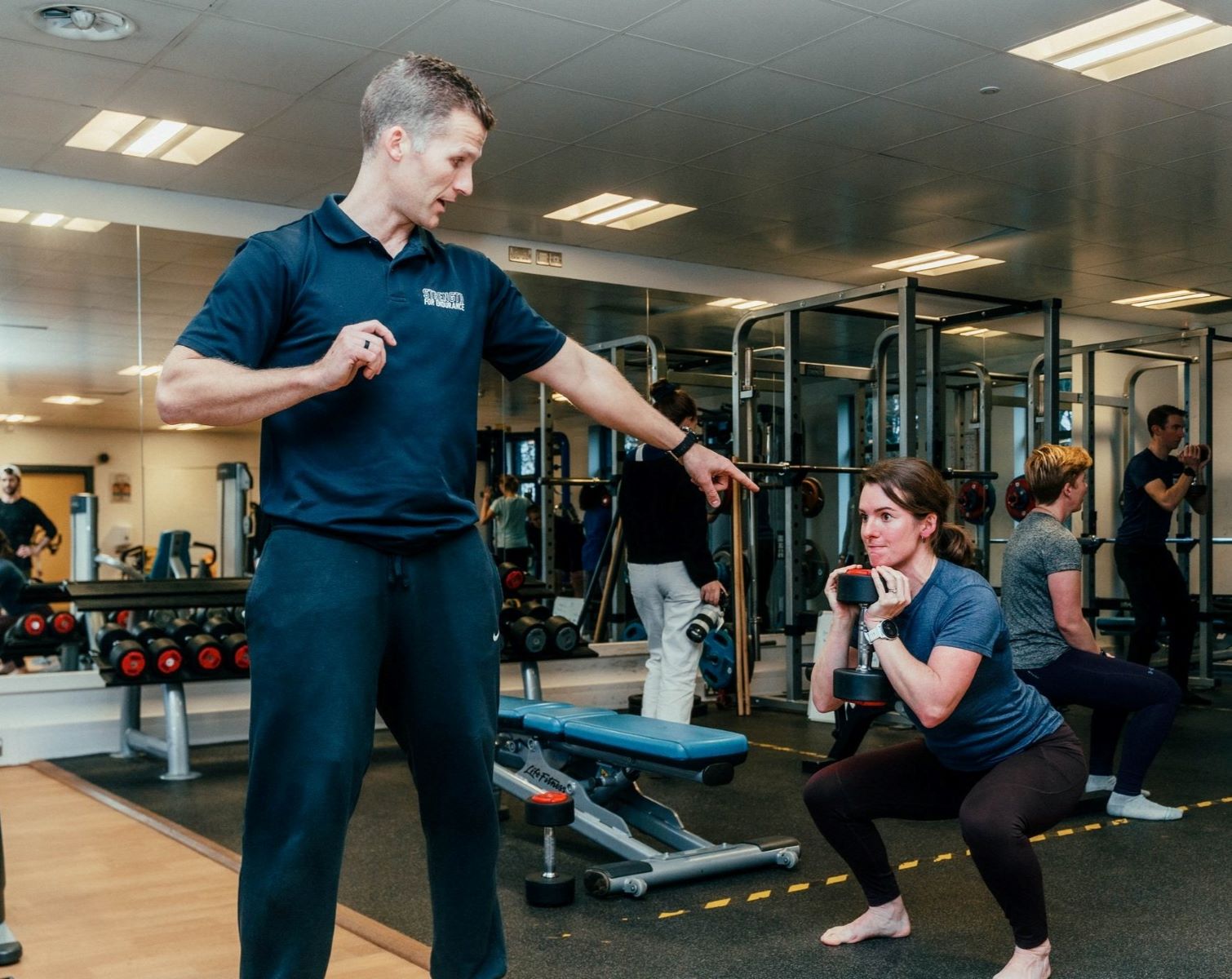Home>Misc>Featured>What Is The Most Important Element In Building Cardiorespiratory Endurance


Featured
What Is The Most Important Element In Building Cardiorespiratory Endurance
Modified: August 21, 2023
Discover the vital role of featured exercises in boosting cardiorespiratory endurance, enabling you to improve your overall fitness and reach your performance goals.
Introduction
Cardiorespiratory endurance is a vital component of overall fitness and plays a crucial role in maintaining a healthy lifestyle. It refers to the ability of the heart, lungs, and circulatory system to deliver oxygen and nutrients to the muscles during prolonged periods of physical activity. In simpler terms, it is the measure of how efficiently your body can supply oxygen to working muscles and remove waste products.
Cardiorespiratory endurance is essential for activities that require sustained effort, such as running, cycling, swimming, or even brisk walking. It not only helps improve athletic performance but also enhances everyday activities like climbing stairs or carrying groceries. By boosting our capacity to endure physical exertion, cardiorespiratory endurance contributes to better stamina, increased energy levels, and improved overall health.
Without sufficient cardiorespiratory endurance, simple tasks may leave us feeling exhausted and breathless, limiting our ability to perform physical activities. Improving our cardiorespiratory endurance allows us to push ourselves further and achieve optimal fitness levels.
In this article, we will delve into the importance of cardiorespiratory endurance and discuss various factors that can affect it. We will explore training methods, nutrition guidelines, and the significance of rest and recovery in enhancing and maintaining cardiorespiratory endurance. By the end, you will have a deeper understanding of how to build this vital element of fitness into your routine and improve your overall health and well-being. So, let’s get started!
Definition of Cardiorespiratory Endurance
Cardiorespiratory endurance, also known as cardiovascular endurance or aerobic fitness, is the ability of the heart, lungs, and circulatory system to sustain prolonged physical activity. It is a measure of how efficiently these organs and systems can deliver oxygen and nutrients to the working muscles during exercise and remove waste products such as carbon dioxide.
During aerobic activities, such as jogging, cycling, or swimming, our body requires a continuous supply of oxygen to produce energy. The heart pumps oxygenated blood to the muscles, and the lungs facilitate the exchange of oxygen and carbon dioxide. The circulatory system transports the oxygen-rich blood to the muscles and helps eliminate waste products.
A high level of cardiorespiratory endurance enables individuals to perform activities that demand sustained effort for an extended period of time without experiencing excessive fatigue or shortness of breath. It allows for improved stamina, increased capacity for physical work, and enhanced overall fitness.
Cardiorespiratory endurance is typically assessed using methods such as the maximum oxygen consumption (VO2 max) test or the submaximal exercise test, which measure the body’s ability to consume oxygen during physical activity. These tests provide valuable information about an individual’s aerobic capacity and can help determine the effectiveness of training programs.
It is important to note that cardiorespiratory endurance is specific to aerobic activities that primarily engage large muscle groups and elevate the heart rate for an extended period of time. It differs from muscular endurance, which relates to the ability of specific muscles to exert force repeatedly.
Understanding the definition of cardiorespiratory endurance is essential for recognizing its significance in overall fitness and the benefits it brings to daily life. Now that we have a clear understanding of this vital component of physical fitness, let’s explore why it is important to develop and maintain cardiorespiratory endurance.
Importance of Cardiorespiratory Endurance
Cardiorespiratory endurance plays a crucial role in maintaining overall health and well-being. Here are some key reasons why it is important to develop and maintain a high level of cardiorespiratory endurance:
1. Improved Heart Health: Regular aerobic exercise strengthens the heart muscle, improves circulation, and lowers blood pressure. It reduces the risk of cardiovascular diseases such as heart attacks, strokes, and coronary artery disease.
2. Increased Stamina and Energy: Building cardiorespiratory endurance increases your capacity to perform physical activities for longer periods without fatigue. This leads to improved stamina and higher energy levels throughout the day, allowing you to engage in daily tasks more efficiently.
3. Weight Management: Engaging in aerobic activities burns calories and helps maintain a healthy weight. The increased calorie expenditure during cardio exercises helps in achieving and sustaining weight loss goals.
4. Stress Reduction: Regular aerobic exercise stimulates the release of endorphins, also known as “feel-good” hormones, which help reduce stress, improve mood, and enhance overall well-being. It acts as a natural stress-reliever, promoting mental and emotional health.
5. Enhanced Lung Capacity: Cardiorespiratory endurance exercises improve lung function by increasing the efficiency of oxygen exchange and expanding lung capacity. This leads to improved respiratory health and increased overall lung performance.
6. Lower Risk of Chronic Diseases: Regular aerobic exercise has been linked to a reduced risk of chronic diseases such as type 2 diabetes, certain types of cancer, and metabolic disorders. It also helps in managing existing conditions like diabetes and high blood pressure.
7. Improved Cognitive Function: Aerobic exercise enhances brain function by increasing blood flow to the brain, promoting the release of chemicals that support brain health and cognitive function. It improves memory, attention, and overall mental sharpness.
8. Longevity: Developing and maintaining cardiorespiratory endurance can increase longevity and improve overall quality of life. People with higher aerobic fitness levels tend to have a lower risk of premature death and enjoy a higher level of physical independence as they age.
Incorporating regular aerobic exercise into your routine is essential for reaping the numerous benefits of cardiorespiratory endurance. By improving your heart health, boosting energy levels, managing weight, and reducing the risk of chronic diseases, you can enjoy a healthier, more fulfilling life. Now that we understand the importance of cardiorespiratory endurance, let’s explore the factors that can affect its development and how to improve it through training methods.
Factors Affecting Cardiorespiratory Endurance
Several factors can impact an individual’s cardiorespiratory endurance. Understanding these factors is essential for designing effective training programs and achieving optimal results. Here are the key factors that influence cardiorespiratory endurance:
1. Genetics: Genetic factors play a role in determining an individual’s baseline cardiorespiratory endurance level. Some people may naturally have a higher aerobic capacity due to their genetic makeup, whereas others may have to put in more effort to develop and improve it.
2. Age: Cardiorespiratory endurance tends to decline with age. As we get older, the heart and lungs may not function as efficiently, which can impact aerobic capacity. However, regular exercise can slow down this decline and maintain cardiovascular fitness even in older individuals.
3. Body Composition: Body composition, specifically the ratio of lean muscle mass to body fat, can affect cardiorespiratory endurance. Having a higher muscle mass can contribute to better oxygen utilization and endurance, while excess body fat can put strain on the cardiovascular system.
4. Training Status: The current level of physical fitness and training can significantly affect cardiorespiratory endurance. Those who engage in regular aerobic exercise and have a well-developed fitness base are likely to have higher endurance levels compared to sedentary individuals.
5. Exercise Intensity: The intensity of aerobic exercise directly impacts cardiorespiratory endurance. Higher intensity workouts challenge the cardiovascular system and stimulate adaptations that increase endurance over time. It is important to progressively increase intensity to avoid overtraining and injury.
6. Exercise Duration: The duration of aerobic exercise sessions influences cardiorespiratory endurance. Longer workouts allow the body to adapt and improve oxygen delivery capacity, leading to enhanced endurance. However, both short high-intensity workouts and longer low-intensity workouts can have positive effects when incorporated appropriately.
7. Training Frequency: Consistency is key when it comes to improving cardiorespiratory endurance. Regular training sessions allow the body to adapt and build endurance over time. Aim for at least 150 minutes of moderate aerobic activity or 75 minutes of vigorous aerobic activity per week, spread across several days.
8. Other Lifestyle Factors: Lifestyle factors such as nutrition, hydration, sleep quality, and stress levels can also impact cardiorespiratory endurance. Adequate nutrition and hydration support energy production and muscle function, while proper rest and recovery allow for adaptation and improvement.
By considering these factors and implementing appropriate strategies, individuals can work towards enhancing their cardiorespiratory endurance levels. In the next section, we will explore different training methods that can be utilized to improve and develop cardiorespiratory endurance effectively.
Training Methods for Enhancing Cardiorespiratory Endurance
Improving cardiorespiratory endurance requires a systematic approach that incorporates specific training methods. Here are some effective strategies to enhance and develop your endurance:
1. Aerobic Exercise: Engaging in aerobic exercises such as running, cycling, swimming, or brisk walking is the foundation for improving cardiorespiratory endurance. Start with moderate-intensity workouts and gradually increase the duration and intensity over time.
2. Interval Training: Interval training involves alternating between high-intensity bursts of exercise and periods of lower intensity or rest. This method challenges the cardiovascular system and can help improve endurance more efficiently than continuous moderate-intensity exercise.
3. Long, Slow Distance (LSD) Training: Incorporating longer duration exercises at a steady but lower intensity can help build endurance. LSD training improves aerobic capacity, teaches the body to use fat as a fuel source, and increases resistance to fatigue.
4. High-Intensity Interval Training (HIIT): HIIT involves short bursts of high-intensity exercise followed by brief recovery periods. It is an effective method for improving cardiorespiratory endurance, as it stimulates adaptations in the heart and lungs and increases overall fitness levels.
5. Cross-Training: Engaging in a variety of aerobic activities can prevent boredom, improve overall fitness, and enhance cardiorespiratory endurance. Incorporate activities such as swimming, cycling, rowing, or using cardio machines to challenge different muscle groups and stimulate varying cardiovascular responses.
6. Progressive Overload: Gradually increasing the intensity, duration, or frequency of your workouts is essential for continual improvement in cardiorespiratory endurance. This progressive overload principle encourages the body to adapt and develop endurance capacity over time.
7. Group Fitness Classes: Participating in group fitness classes can be motivating and enjoyable while providing structured workouts that target cardiorespiratory endurance. Classes like spinning, aerobics, or dance-based workouts offer a fun and challenging way to improve endurance.
8. Monitoring Heart Rate: Using a heart rate monitor or tracking device can help ensure that you are in the appropriate intensity zone for improving cardiorespiratory endurance. Aim for a target heart rate zone based on your age and fitness level during aerobic exercise.
9. Consistency: Regularity is key when it comes to improving endurance. Aim for at least three to five aerobic workouts per week, with a mix of different training methods to challenge the body and avoid plateaus.
Remember to listen to your body and progress at a pace that is suitable for your current fitness level. It is important to consult with a healthcare professional or a certified fitness trainer before starting any new workout routine, especially if you have any underlying health conditions.
By incorporating these training methods and maintaining consistency, you can enhance your cardiorespiratory endurance, improve overall fitness, and enjoy the numerous health benefits that come with it. In the next section, we will discuss the role of nutrition and hydration in supporting and optimizing cardiorespiratory endurance.
Nutrition and Hydration for Improving Cardiorespiratory Endurance
Proper nutrition and hydration play a vital role in supporting and optimizing cardiorespiratory endurance. Here are some key considerations to improve your performance and enhance endurance:
1. Stay Hydrated: Adequate hydration is critical for optimal performance and endurance. Drink water throughout the day and increase fluid intake before, during, and after exercise. Aim to consume about 8-10 cups of water daily.
2. Consume Balanced Macronutrients: Include a balanced mix of carbohydrates, proteins, and healthy fats in your diet to fuel your workouts and support muscle recovery. Carbohydrates provide readily available energy, proteins help repair and build muscles, and healthy fats aid in sustaining energy levels.
3. Prioritize Complex Carbohydrates: Choose whole grains, fruits, vegetables, and legumes as your primary sources of carbohydrates. These provide sustained energy for longer duration workouts and help maintain stable blood sugar levels.
4. Include Lean Proteins: Incorporate lean proteins such as chicken, fish, tofu, beans, and Greek yogurt in your meals. Protein is essential for muscle repair and recovery, supporting your endurance training efforts.
5. Healthy Fats: Include sources of healthy fats like avocados, nuts, seeds, and olive oil in your diet. These fats provide essential fatty acids and help sustain energy levels during endurance exercise.
6. Eat Before and After Exercise: Consume a balanced meal or snack containing carbohydrates and proteins before exercising to provide energy and prevent muscle breakdown. After exercise, have a post-workout meal or snack to aid in muscle recovery and glycogen replenishment.
7. Timing of Meals: Time your meals appropriately to provide adequate fuel for your workouts. Eat a light meal or snack about 1-2 hours before exercise and have a post-workout meal within 30-60 minutes after your workout.
8. Consider Pre-Workout Supplements: Some individuals may benefit from utilizing pre-workout supplements that contain ingredients like caffeine, creatine, and beta-alanine. However, it is essential to consult with a healthcare professional or a sports nutritionist before incorporating any supplements into your routine.
9. Recovery Nutrition: In addition to pre and post-workout nutrition, prioritize recovery nutrition by consuming a mix of carbohydrates and proteins within a couple of hours after exercise. This helps replenish glycogen stores, repair muscle tissues, and enhance recovery.
10. Listen to Your Body: Every individual has different nutritional needs, and it’s important to listen to your body. Pay attention to how different foods affect your energy levels and performance, and adjust your diet accordingly.
Remember, nutrition and hydration are individualized, and what works for one person may not work for another. It is advisable to consult with a registered dietitian or a sports nutritionist who can provide personalized guidance based on your specific needs and goals.
Optimizing your nutrition and hydration will fuel your workouts, support your endurance training, and improve overall performance. In the final section, we will discuss the role of rest and recovery in maintaining cardiorespiratory endurance.
Rest and Recovery for Maintaining Cardiorespiratory Endurance
Rest and recovery are integral components of maintaining cardiorespiratory endurance. While consistent exercise is essential for improving endurance, giving your body adequate time to rest and recover is equally important. Here are some key considerations for rest and recovery:
1. Incorporate Rest Days: Schedule regular rest days where you engage in lighter intensity activities or take a complete day off from exercise. This allows your muscles to recover and rebuild, reducing the risk of overuse injuries.
2. Sleep: Aim for an adequate amount of sleep to support your body’s recovery processes. Quality sleep enhances muscle repair, hormone regulation, and overall physical and mental well-being. Strive for 7-9 hours of uninterrupted sleep each night.
3. Listen to Your Body: Pay attention to any signs of fatigue, muscle soreness, or decreased performance. If your body is signaling the need for rest, honor it and adjust your training accordingly.
4. Active Recovery: On rest days, consider engaging in light activities such as gentle stretching, yoga, or walking. This promotes blood flow, helps flush out metabolic waste, and aids in muscle recovery.
5. Recovery Techniques: Utilize various recovery techniques such as foam rolling, massages, cold or hot therapy, and compression garments to reduce muscle soreness and promote faster recovery.
6. Proper Nutrition: A well-balanced diet, as discussed earlier, plays a crucial role in recovery. Ensure you are consuming adequate nutrients, especially carbohydrates and proteins, to support muscle repair and replenish energy stores.
7. Manage Stress: Chronic stress can hamper recovery and hinder progress. Incorporate stress management techniques such as mindfulness, meditation, deep breathing exercises, or engaging in activities you enjoy to promote a balanced lifestyle.
8. Gradual Progression: Avoid sudden increases in training volume or intensity, as it can lead to overtraining and burnout. Gradually progress your workouts to allow your body to adapt and avoid excessive stress on the cardiovascular system.
9. Work-Life Balance: Balancing your training with other aspects of life, including work, relationships, and hobbies, is important for overall well-being. Avoid overcommitting yourself and be mindful of finding a healthy equilibrium.
10. Professional Guidance: If you are experiencing persistent fatigue, decreased performance, or other concerning symptoms, it is recommended to seek guidance from a healthcare professional or sports specialist. They can provide a comprehensive evaluation and tailor recovery strategies based on your individual needs.
Remember, rest and recovery are not signs of weakness, but rather an essential part of the training process. By prioritizing adequate rest, you can optimize your cardiorespiratory endurance, prevent injuries, and achieve long-term sustainable progress. Now, let’s wrap up this article and summarize the key points discussed.
Conclusion
Cardiorespiratory endurance is a critical component of overall fitness and plays a vital role in maintaining a healthy lifestyle. By improving your cardiorespiratory endurance, you can enhance your performance, increase stamina, and enjoy numerous health benefits.
Throughout this article, we discussed the definition of cardiorespiratory endurance and its importance in daily life. We explored the factors that can affect endurance, such as genetics, age, and training status. We also delved into various training methods, including aerobic exercises, interval training, and cross-training, to improve cardiorespiratory endurance.
Furthermore, we emphasized the significance of nutrition and hydration in supporting endurance training. Adequate hydration, balanced macronutrients, and proper timing of meals are key considerations to fuel your workouts and aid in recovery. Additionally, we discussed the role of rest and recovery in maintaining cardiorespiratory endurance, highlighting the importance of rest days, sleep, and active recovery.
By implementing these strategies and considering individual needs, you can enhance your cardiorespiratory endurance, boost your overall fitness, and improve your quality of life. It is important to remember that every individual is unique, and listening to your body is essential in effectively and safely improving endurance levels.
So, whether you are an athlete aiming to enhance performance or someone seeking to improve overall fitness, focus on developing and maintaining cardiorespiratory endurance. Make it a part of your fitness routine, integrate proper nutrition and hydration, prioritize rest and recovery, and enjoy the long-term benefits that come with a strong cardiovascular system.
Start small, be consistent, and gradually progress as your endurance improves. Consult with professionals, such as healthcare providers, fitness trainers, or nutritionists to design a personalized plan that suits your needs and goals. With dedication and perseverance, you can attain optimal cardiorespiratory endurance and lead a more active and fulfilling life.









